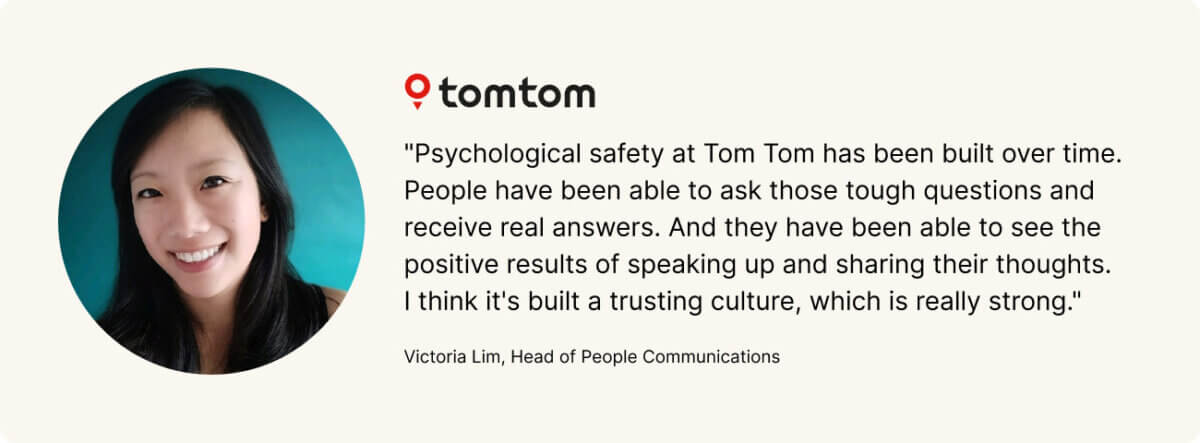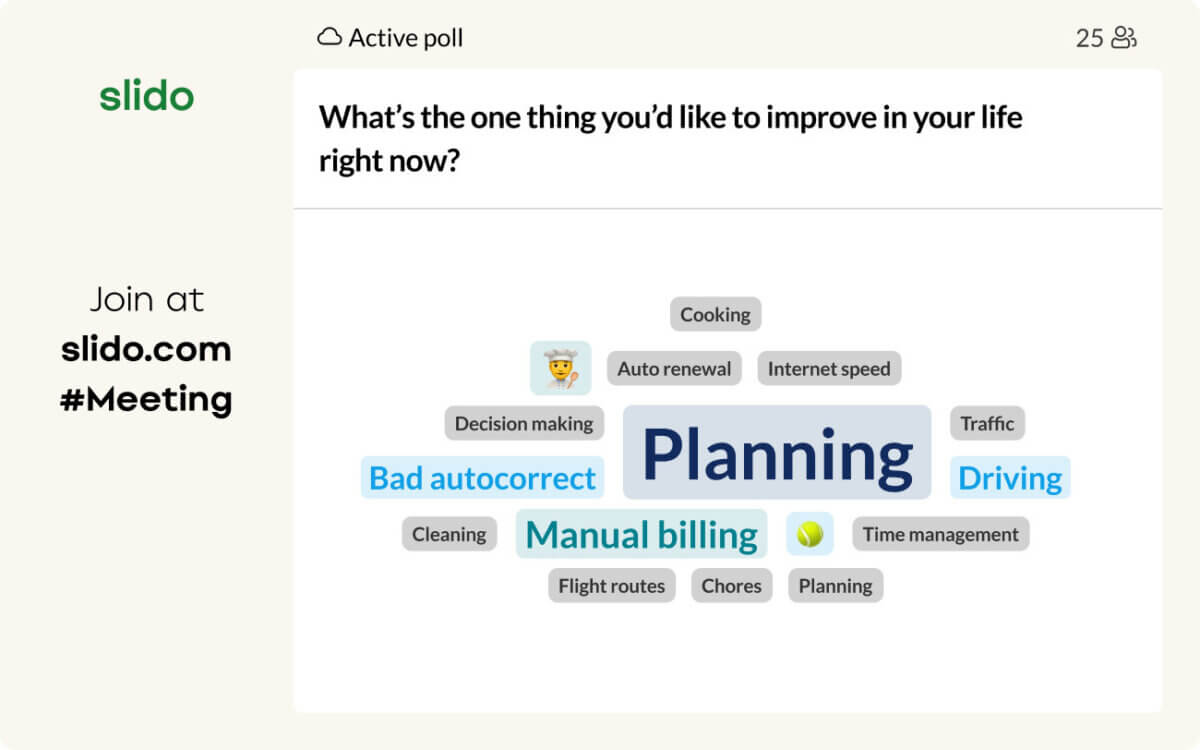Having started in the events space, Slido has always strived to ‘give the audience a voice ’. However, over the last 11 years, we’ve slowly evolved toward ‘giving everyone a voice ’ and building a great meeting culture.
For us, this somewhat organic change of direction came down to simple statistics.
On average, people are estimated to attend 62 meetings per month. But, over 42% of meeting participants leave these meetings without ever saying what is on their minds.
This is a clear indicator of why participation doesn’t necessarily translate to productive collaboration.
Without true dialogue, meetings become an echo chamber for the strongest and loudest voices. In such meetings, diversity of thought continues to be a distant dream. But we’re here to change that.
To drive our new mission, we have come up with the concept of great meeting culture. In this blog, we’ll explore what a great meeting culture is and why we’ve made it an essential part of our story.
- What is a great meeting culture and why is it important?
- What are the benefits of investing in your meeting culture?
- 5 tips to build a great meeting culture
What is a great meeting culture and why is it important?
Tapping into the full potential of interaction, a great meeting culture enables people to connect more meaningfully. It begins by reimagining why we meet, when we meet, and how we meet.
At Slido, we define a great meeting culture as a set of rituals, practices, and beliefs that promote effective communication, active participation, and meaningful collaboration during meetings. This includes canceling meetings that don’t make sense.
Great meeting culture became the cornerstone of our brand story when we realized the profound impact it could have on company culture. To test our hypothesis further, we ran a qualitative study conducted among C-suite executives from the US, about what role meetings play in their culture.
Here’s what one of them told us:
“Is there an honest exchange of ideas? Is there open but respectful disagreement? And if there isn’t, then there’s something more fundamentally wrong with the culture.”

When leaders empower their people through interaction and engagement, it creates a ripple effect and drives transparency within the organization, leading to increased levels of trust. To demonstrate this, we use the concept of the Slido iceberg or the meeting iceberg.
Our study shows that by viewing meetings as a key driver of culture, organizations are better able to nurture an environment of trust, inclusivity, diversity of thought, and productive collaboration*.
In organizations with great meeting cultures, every meeting is purposeful and engaging. They’re led with clear objectives, effective facilitation, and opportunities for all participants to contribute.
TomTom, Swiggy, Cisco, and Glovo are some of the many clients who have demonstrated the power of great meetings to us time and again.
What are the benefits of investing in your meeting culture?
At its core, a great meeting culture aims to facilitate a free flow of information between the meeting host and the participants.
Whether it is between leaders and teams or among peers, this two-way communication or feedback loop helps people ask the right questions and allows leaders to provide clarity and guidance wherever possible. Apart from enabling better alignment, this delivers three key benefits for organizations in the long run:
- Productive collaboration: A great meeting culture demands structure and preparation in meetings. This helps participants to remain focused, make informed decisions, and achieve desired outcomes.
- Greater innovation and trust: Employees feel empowered and motivated to contribute their ideas, fostering innovation, creativity, diverse perspectives, and effective problem-solving.
- Improved organizational health: Better communication combined with increased levels of transparency, and trust among team members will help build a positive work atmosphere.

5 tips to build a great meeting culture
Leaders who value good company culture often practice leading by example. They bring the culture they want to achieve in their organizations to all their interactions, including meetings.
Whether you’re soliciting feedback, or trying to engage people, ‘being intentional about the change you want to affect’ is key when building your meeting culture. We talked to 18 C-suite executives* to bring you five practical guidelines to build a great meeting culture:
1. Conduct a meeting audit
This is where you take stock of all your meetings. The audit could be done at a team level or department level to keep the scope more manageable.
At Slido, we do this by asking people about the meetings they enjoy the most. Such insights will help build a better understanding of what works and what doesn’t. Based on the feedback you receive, consider alternative formats for the not-so-popular meetings.
💡One thing that helped us the most is replacing status update meetings with asynchronous video messages or vidcasts.
2. Embrace technology as an enabler
Whether you want to enable transparency in decision-making, encourage more participation, or gather value insights from your participants, technology can give you an edge.
Using tools like polling and Q&A platforms can be highly effective in unlocking unique perspectives that otherwise stay hidden. However, effective facilitation and positive reinforcement from the leaders are indispensable for the successful adoption of any such technology, including Slido.
3. Create a ‘culture moment’ in every meeting
One of our respondents told us that actively creating room for personalized connection is paramount to them. “Whether that’s something from the field or something that’s going on in our work or family…we’re religious about it. It sets the tone for respect and empathy and people look forward to it.”
🏁 The key here is to add a personal touch to the discussion and build on to the topic.
4. Foster psychological safety within your teams
To encourage more participation and engagement in meetings, leaders need to nurture a safe space for feedback. When the fear of backlash is removed, people will feel more confident sharing their thoughts and asking questions.
If you’re looking for more openness and transparency within your team, a team meeting provides the perfect opportunity to model this behavior to your colleagues. You can read more about this in our psychological safety blog.
5. Be open to experimenting
Every organization operates differently. Even within an organization, there may be teams that require more meetings than others.
The point is, there is no one-size-fits-all approach when it comes to meeting transformation. Some teams may continue to have many meetings, but a great meeting culture will help make their meetings structured, brief, and to the point. For others, fewer meetings will work better. Their great meeting culture will be asynchronous at its core. The key is to keep experimenting and improving wherever possible.
💚 Be sure to check in with your teams often to understand what would help them the most.
This article is authored by Jonny Young, the Head of Brand at Slido and one of the key figures behind the concept of great meeting culture. The piece is edited by Arya P Dinesh.
References: Building and Maintaining a Healthy Workplace Culture: A Qualitative Study of Leaders of Leaders, May 2023





